
In April's Spurtle, John Ross Maclean describes the Ruskin pencil drawing of 1838 (now in Birmingham Museums & Art Gallery), which was long held to depict Lady Glenorchy’s Church (see Issue 238). It is in fact of Trinity College Kirk which stood in the valley between the Old Town and Calton Hill on the west side of Leith Wynd. Here he returns to the subject in a little more detail than we had room for in print.
Contemporary pictures suggest a building of robust splendour which would have appealed to Ruskin. Although only 19 when he drew this image during a tour of Scotland with his parents, he was already a highly accomplished draughtsman.

The transept functioned as a grand parish church from c.1580–1848. It was then dismantled to make way for Waverley Station, with masonry being carefully numbered to aid reconstruction later. (Some of the painted numbers still survive.)
In the meantime, the stones were stored on Calton Hill, from where they were regularly stolen by local builders.

The building's 'huge lancets and deep buttresses' are best seen from Trunk's Close, and the exterior boasts also a green man and a baker's dozen of fine gargoyles.
[Photo top-right reproduced by courtesy of www.edinphoto.org.uk. Sepia map: W. & A.K. Johhnston Ltd, 1837. Bird's eye view of Edinburgh in 1647 by James Gordon of Rothiemay: Wikipedia creative commons.]